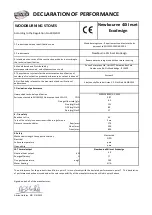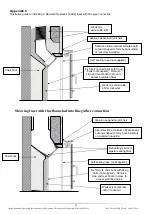
2
Installation and Operating Instructions for Newbourne 40i Inset Inset Ecodesign Multi Fuel Stove
Ref: Pevex1030/AH/ver1: 1 April 2019
Congratulations on the purchase of your new Newbourne 40i Inset Ecodesign Stove. Your new purchase will
provide you with a level of pleasure and comfort not previously experienced in your home.
The Newbourne 40i Inset is a heavy duty British designed multifuel stove. It has been designed for easy
installation and ease of use giving a lovely flame pattern when burning wood and a wonderful warm radiant and
convection heat. The stove is highly efficient with a clean burn firebox and efficiencies above 76% (Net) when
burning wood and features a full size door, large glass window, vermiculite insulated firebox, convector top plate,
easy to use lift up handle and heavy weight steel construction.
Please read and follow the advice and instructions on the safe and efficient operation of your stove to
ensure it has a long trouble free life and also read and follow the installation instructions before installing
the stove.
PART 1 OPERATING INSTRUCTIONS
A stove compared with an open fire is a very efficient heating appliance and must be installed and used safely
and wisely, it is important to understand the working of such an appliance and to understand the process of
converting the fuel into heat and its efficient transfer from the firebox to the room in order to gain the most from
the stove.
A stove creates an almost perfect environment to burn wood in. The firebox will run at a very high temperature
ideal to burn the volatiles given off in the burning process and the precise air controls allow minimal heat loss
into the flue. The Newbourne 40i Inset Ecodesign stove operates at an efficiency of approx 70% Gross CV basis
(+76% Net) and is very much more efficient than an open fire avoiding the wasteful draughts normally associated
with that type of appliance
Burning wood is the natural way to store the sun’s energy to then be released in a carbon neutral process to
heat your house when the need is most. On a cold winters night there is nothing to beat the release of heat and
flame in a stove to raise the spirit.
The preparation and burning of wood as a fuel in stoves can be traced back many centuries, however it is a
forgotten or maybe never fully discovered activity in the United Kingdom, we have much to learn from our
European and Scandinavian neighbours whose colder winters have instinctively led them into a natural wood
burning culture.
Wood for fuel is probably one of the most environmentally friendly energy sources, it is carbon neutral, trees
used for fuel production regenerate very quickly and it is a pleasant and satisfying job preparing the firewood for
the coming winters.
WARNING NOTE
Properly installed, operated and maintained this stove will not emit fumes into the dwelling. Occasional fumes
from de-ashing and refueling may occur. However, persistent fume emission is potentially dangerous and must
not be tolerated. If fume emission persists, then the following immediate action should be taken:
a) Open doors and windows to ventilate room and then leave the premises.
b) Let the fire go out.
c) Check for flue or chimney blockage and clean if required
d) Do not attempt to relight the fire until the cause of the fume emission has been identified and corrected.
If necessary seek expert advice
The most common cause of fume emission is flue way or chimney blockage. For your own safety these must
be kept clean at all times.
Any permanent air vent provided for combustion air must not be blocked off
.
There must not be an extractor fan fitted in the same room as the stove as this can cause the stove to
emit dangerous fumes into the room.
Your installer should have fitted a CO alarm in the same room as the appliance. If the alarm sounds unexpectedly
then follow procedures a-d as shown above.
CHIMNEY CLEANING
The chimney should be swept at least once a year for smokeless fuels and a minimum of twice a year for wood
and other fuels. It is important that the flue connection and chimney are swept prior to lighting up after a
prolonged shutdown period. If the stove is fitted in place of an open fire then the chimney should be swept one
month after installation to clear any soot falls which may have occurred due to the difference in combustion
between the stove and the open fire.
In situations where it is not possible to sweep through the stove the installer will have provided alternative means
such as a soot door. After sweeping the chimney, the stove flue outlet and the flue pipe connecting the stove to
the chimney must be cleaned with a flue brush.

































